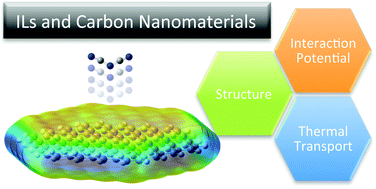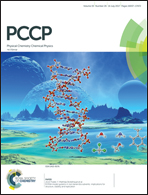Molecular interactions and thermal transport in ionic liquids with carbon nanomaterials†
Abstract
We used molecular dynamics simulation to study the effect of suspended carbon nanomaterials, nanotubes and graphene sheets, on the thermal conductivity of ionic liquids, an issue related to understanding the properties of nanofluids. One important aspect that we developed is an atomistic model of the interactions between the organic ions and carbon nanomaterials, so we did not rely on existing force fields for small organic molecules or assume simple combining rules to describe the interactions at the liquid/material interface. Instead, we used quantum calculations with a density functional suitable for non-covalent interactions to parameterize an interaction model, including van der Waals terms and also atomic partial charges on the materials. We fitted a n–m interaction potential function with n values of 9 or 10 and m values between 5 and 8, so a 12-6 Lennard-Jones function would not fit the quantum calculations. For the atoms of ionic liquids and carbon nanomaterials interacting among themselves, we adopted existing models from the literature. We studied the imidazolium ionic liquids [C4C1im][SCN], [C4C1im][N(CN)2], [C4C1im][C(CN)3] and [C4C1im][(CF3SO2)2N]. Attraction is stronger for cations (than for anions) above and below the π-system of the nanomaterials, whereas anions show stronger attraction for the hydrogenated edges. The ordering of ions around and inside (7,7) and (10,10) single-walled nanotubes, and near a stack of graphene sheets, was analysed in terms of density distribution functions. We verified that anions are found, as well as cations, in the first interfacial layer interacting with the materials, which is surprising given the interaction potential surfaces. The thermal conductivity of the ionic liquids and of composite systems containing one nanotube or one graphene stack in suspension was calculated using non-equilibrium molecular dynamics. Thermal conductivity was calculated along the axis of the nanotube and across the planes of graphene, in order to see the anisotropy. In the composite systems containing the nanotube, there is an enhancement of the overall thermal conductivity, with calculated values comparing well with experiments on nanotube suspensions, namely in terms of the order of the different ionic liquids. In the systems containing the graphene stack, the interfacial region of the ionic liquid near the surface of the material has an enhanced thermal conductivity with respect to the bulk liquid, but no significant discontinuity in the temperature profiles were observed. This is important information for models of thermal conduction in nanofluids.



 Please wait while we load your content...
Please wait while we load your content...